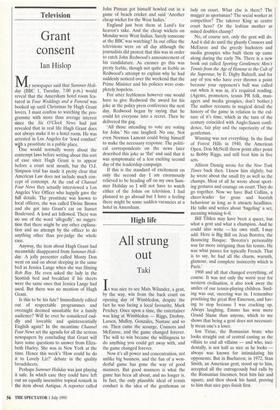High life
All strung out
Taki
It was nice to see Mats Wilander, a gent, by the way, win from the back court on opening day of Wimbledon, despite the fact he was facing a local favourite, Mark Petchey. Once upon a time, the entertainer was king at Wimbledon — Riggs, Drobny, Larsen, Mulloy, Gonzales, Nastase and so on. Then came the scourge, Connors and McEnroe, and the game changed forever. The will to win became the willingness to do anything you could get away with, and the game changed forever.
Now it's all power and concentration, not unlike big business, and the fun of a won- derful game has gone the way of good manners. But good manners is what the game has been all about, and no longer is. In fact, the only plausible ideal of tennis conduct is the idea of the gentleman or lady on court. What else is there? The mugger as sportsman? The social worker as competitor? The takover King as centre court hero? Or the lesbian mother as mixed doubles champ?
No, of course not, only the gent will do. And it did do until the ghastly Connors and McEnroe and the greedy hucksters and media groupies who built them up came along during the early 70s. There is a new book out called Sporting Gentlemen: Men's Tennis from the Age of Honour to the Cult of the Superstar, by E. Digby Baltzell, and for any of you who have ever thrown a point because your opponent's ball was called out when it was in, it's required reading. (Agents, promoters, tennis PR folk, man- agers and media groupies, don't bother.) The author recounts in magical detail the history of the game in relation to the cul- ture of it's time, which in the turn of the century coincided with Anglo-Saxon confi- dence, fair play and the superiority of the gentleman.
Winning was not everything. In the final of Forest Hills in 1940, the American Open, Don McNeill threw point after point to Bobby Riggs, and still beat him in five sets.
Allison Danzig wrote for the New York Times back then. I knew him slightly, but he wrote about the small fry as well as the champs. Most of all he wrote about sport- ing gestures and courage on court. They do go together. Now we have Bud Collins, a cheer-leader for gross and boorish behaviour as long as it attracts headlines. He talks and writes about `bageling' a set, meaning winning 6-0.
Bill Tilden may have been a queer, but what a gent and what a champion. And he could also write — his own stuff, I may add. Here is Big Bill on Jean Borotra, the Bouncing Basque: 'Borotra's personality was far more intriguing than his tennis. He was what passes for typically French. That is to say, he had all the charm, warmth, glamour, and complete insincerity which is Paris.'
1968 and all that changed everything, of course. It was not only the worst year for western civilisation, it also took away the smiles of our tennis-playing children. Smil- ing was out, sneering was in. I remember practising the great Roy Emerson, and hav- ing to stop because I was cracking up. Always laughing, Emmo has won more Grand Slams than anyone, which to me shows that being a gent does not necessari- ly mean one's a loser.
Ion Tiriac, the Romanian brute who looks straight out of central casting as the villain to end all villains — and who, inci- dentally, is not half as nice as he looks always was known for intimidating his opponents. But in Bucharest, in 1972, Stan Smith, an American gent, stood up to him, accepted all the outrageously bad calls by the Romanian linesmen, beat him fair and square, and then shook his hand, proving to him that nice guys finish first. But do they? Tiriac is a multi-millionaire, Smith just well off. Still, Sampras and a few Swedes are trying to return to decency and a respect for tradition, although the school of the Gentleman — as Jeffrey Hart wrote — 'does not award "Pass" ' degrees. I do not think a gent will repeat this year, nor a Swede.



































































 Previous page
Previous page